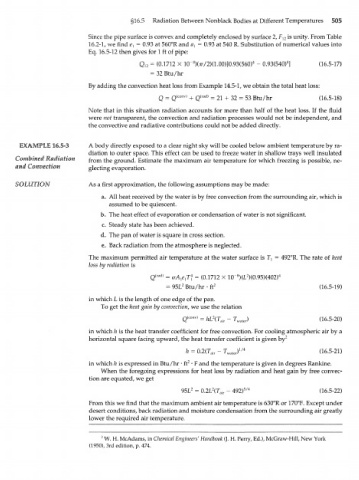Page 525 - Bird R.B. Transport phenomena
P. 525
§16.5 Radiation Between Nonblack Bodies at Different Temperatures 505
Since the pipe surface is convex and completely enclosed by surface 2, F ]2 is unity. From Table
16.2-1, we find e ] = 0.93 at 560°R and a x = 0.93 at 540 R. Substitution of numerical values into
Eq. 16.5-12 then gives for 1 ft of pipe:
4
8
Q u = (0.1712 X 10" )(тг/2)(1.00)[0.93(560) 4 - 0.93(540) ] (16.5-17)
= 32 Btu/hr
By adding the convection heat loss from Example 14.5-1, we obtain the total heat loss:
Q = Q(conv) + Q(rad) = 2 1 + 3 2 = 5 3 B t u / h r (16.5-18)
Note that in this situation radiation accounts for more than half of the heat loss. If the fluid
were not transparent, the convection and radiation processes would not be independent, and
the convective and radiative contributions could not be added directly.
16.5=3 A body directly exposed to a clear night sky will be cooled below ambient temperature by ra-
diation to outer space. This effect can be used to freeze water in shallow trays well insulated
Combined Radiation from the ground. Estimate the maximum air temperature for which freezing is possible, ne-
and Convection glecting evaporation.
SOLUTION As a first approximation, the following assumptions may be made:
a. All heat received by the water is by free convection from the surrounding air, which is
assumed to be quiescent.
b» The heat effect of evaporation or condensation of water is not significant.
с» Steady state has been achieved.
do The pan of water is square in cross section.
e. Back radiation from the atmosphere is neglected.
The maximum permitted air temperature at the water surface is T x = 492°R. The rate of heat
loss by radiation is
2
= (0.1712 X 10" )(L )(0.95)(402) 4
8
2
= 95L Btu/hr • ft 2 (16.5-19)
in which L is the length of one edge of the pan.
To get the heat gain by convection, we use the relation
Q(conv) _ U 2/rr _ j \ (16.5-20)
in which h is the heat transfer coefficient for free convection. For cooling atmospheric air by a
horizontal square facing upward, the heat transfer coefficient is given by 2
1
= 0.2(T -T water ) - (16.5-21)
air
in which h is expressed in Btu/hr • ft F and the temperature is given in degrees Rankine.
e
2
When the foregoing expressions for heat loss by radiation and heat gain by free convec-
tion are equated, we get
95L 2 = 0.2L (T air - 492) 5 (16.5-22)
2
From this we find that the maximum ambient air temperature is 630°R or 170°F. Except under
desert conditions, back radiation and moisture condensation from the surrounding air greatly
lower the required air temperature.
2 W. H. McAdams, in Chemical Engineers' Handbook (J. H. Perry, Ed.), McGraw-Hill, New York
(1950), 3rd edition, p. 474.

